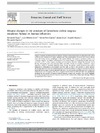Identificador persistente para citar o vincular este elemento:
https://accedacris.ulpgc.es/jspui/handle/10553/11180
| Campo DC | Valor | idioma |
|---|---|---|
| dc.contributor.author | Tuya, F. | es |
| dc.contributor.author | Ribeiro-Leite, Luis | es |
| dc.contributor.author | Arto-Cuesta, Noelia | es |
| dc.contributor.author | Coca, Josep | es |
| dc.contributor.author | Haroun, Ricardo | es |
| dc.contributor.other | Coca Saez de Albeniz, Josep | |
| dc.contributor.other | Haroun, Ricardo | |
| dc.date.accessioned | 2014-01-10T03:30:20Z | - |
| dc.date.accessioned | 2018-03-15T14:26:20Z | - |
| dc.date.available | 2014-01-10T03:30:20Z | - |
| dc.date.available | 2018-03-15T14:26:20Z | - |
| dc.date.issued | 2014 | es |
| dc.identifier.issn | 0272-7714 | es |
| dc.identifier.uri | https://accedacris.ulpgc.es/handle/10553/11180 | - |
| dc.description.abstract | Seagrass meadows are deteriorating worldwide. However, numerous declines are still unreported, which avoid accurate evaluations of seagrass global trends. This is particularly relevant for the western African coast and nearby oceanic archipelagos in the eastern Atlantic. The seagrass Cymodocea nodosa is an ecological engineer on shallow soft bottoms of the Canary Islands. A comparative decadal study was conducted in 21 C. nodosa seagrass meadows at Gran Canaria Island to compare the structure (shoot density, leaf length and cover) between 2003 and 2012. Overall, 11 meadows exhibited a severe regression, while 10 remained relatively stable. During this period, natural influences (sea surface temperature, Chlorophyll-a concentration and PAR light, as well as the number of storm episodes detaching seagrasses) had a low predictive power on temporal patterns in seagrass structure. In contrast, proximity from a range of human-mediated influences (e.g. the number of outfalls and ports) seem to be related to the loss of seagrass; the rate of seagrass erosion between 2003 and 2012 was significantly predicted by the number of human-mediated impacts around each meadow. This result highlights promoting management actions to conserve meadows of C. nodosa at the study region through efficient management of local impacts | es |
| dc.format | application/pdf | es |
| dc.language | eng | es |
| dc.relation.ispartof | Estuarine, Coastal and Shelf Science | es |
| dc.rights | by-nc-nd | es |
| dc.source | Estuarine, Coastal and Shelf Science [ISSN 0272-7714], 9 p. | es |
| dc.subject | 241713 Ecología vegetal | es |
| dc.subject.other | Seagrass | es |
| dc.subject.other | Water quality | es |
| dc.subject.other | Human-mediated impact | es |
| dc.subject.other | Canary Islands | es |
| dc.title | Decadal changes in the structure of Cymodocea nodosa seagrass meadows: natural vs. human influences | es |
| dc.type | info:eu-repo/semantics/Article | es |
| dc.type | Article | es |
| dc.identifier.doi | 10.1016/j.ecss.2013.11.026 | |
| dc.identifier.scopus | 85027923619 | |
| dc.identifier.isi | 000331507000005 | |
| dcterms.isPartOf | Estuarine Coastal And Shelf Science | |
| dcterms.source | Estuarine Coastal And Shelf Science[ISSN 0272-7714],v. 137, p. 41-49 | |
| dc.contributor.authorscopusid | 6603608107 | |
| dc.contributor.authorscopusid | 57195454400 | |
| dc.contributor.authorscopusid | 57195454595 | |
| dc.contributor.authorscopusid | 7006741572 | |
| dc.contributor.authorscopusid | 6603827643 | |
| dc.contributor.authorscopusid | 55959248800 | |
| dc.identifier.absysnet | 693328 | es |
| dc.description.firstpage | 49 | |
| dc.relation.volume | 137 | |
| dc.investigacion | Ciencias | es |
| dc.rights.accessrights | info:eu-repo/semantics/openAccess | es |
| dc.type2 | Artículo | es |
| dc.identifier.wos | WOS:000331507000005 | |
| dc.contributor.daisngid | 308553 | |
| dc.contributor.daisngid | 14216593 | |
| dc.contributor.daisngid | 20092996 | |
| dc.contributor.daisngid | 1955355 | |
| dc.contributor.daisngid | 458788 | |
| dc.contributor.daisngid | 1880657 | |
| dc.identifier.investigatorRID | H-7067-2015 | |
| dc.identifier.investigatorRID | No ID | |
| dc.contributor.wosstandard | WOS:Tuya, F | |
| dc.contributor.wosstandard | WOS:Ribeiro-Leite, L | |
| dc.contributor.wosstandard | WOS:Arto-Cuesta, N | |
| dc.contributor.wosstandard | WOS:Coca, J | |
| dc.contributor.wosstandard | WOS:Haroun, R | |
| dc.contributor.wosstandard | WOS:Espino, F | |
| dc.date.coverdate | Enero 2014 | |
| dc.identifier.ulpgc | Sí | es |
| dc.description.sjr | 1,067 | |
| dc.description.jcr | 2,057 | |
| dc.description.sjrq | Q1 | |
| dc.description.jcrq | Q2 | |
| dc.description.scie | SCIE | |
| item.grantfulltext | open | - |
| item.fulltext | Con texto completo | - |
| crisitem.author.dept | GIR ECOAQUA: Biodiversidad y Conservación | - |
| crisitem.author.dept | IU de Investigación en Acuicultura Sostenible y Ec | - |
| crisitem.author.dept | Departamento de Biología | - |
| crisitem.author.dept | GIR ECOAQUA: Biodiversidad y Conservación | - |
| crisitem.author.dept | IU de Investigación en Acuicultura Sostenible y Ec | - |
| crisitem.author.dept | GIR ECOAQUA: Biodiversidad y Conservación | - |
| crisitem.author.dept | IU de Investigación en Acuicultura Sostenible y Ec | - |
| crisitem.author.dept | Departamento de Biología | - |
| crisitem.author.orcid | 0000-0001-8316-5887 | - |
| crisitem.author.orcid | 0000-0003-0625-8240 | - |
| crisitem.author.orcid | 0000-0003-1348-692X | - |
| crisitem.author.parentorg | IU de Investigación en Acuicultura Sostenible y Ec | - |
| crisitem.author.parentorg | IU de Investigación en Acuicultura Sostenible y Ec | - |
| crisitem.author.parentorg | IU de Investigación en Acuicultura Sostenible y Ec | - |
| crisitem.author.fullName | Tuya Cortés, Fernando José | - |
| crisitem.author.fullName | Saenz De Albeniz,Josep Coca | - |
| crisitem.author.fullName | Haroun Tabraue, Ricardo Jesús | - |
| Colección: | Artículos | |
Citas SCOPUSTM
64
actualizado el 08-jun-2025
Citas de WEB OF SCIENCETM
Citations
60
actualizado el 08-jun-2025
Visitas
179
actualizado el 31-may-2025
Descargas
526
actualizado el 31-may-2025
Google ScholarTM
Verifica
Altmetric
Comparte
Exporta metadatos
Los elementos en ULPGC accedaCRIS están protegidos por derechos de autor con todos los derechos reservados, a menos que se indique lo contrario.
